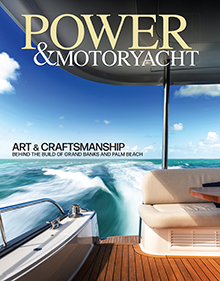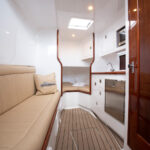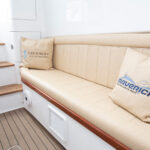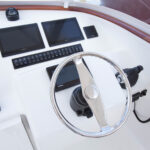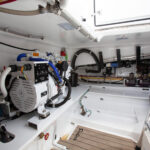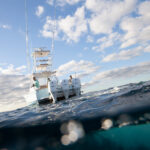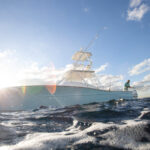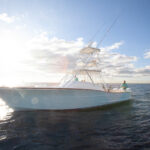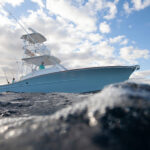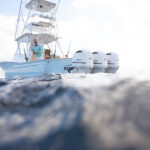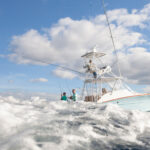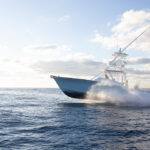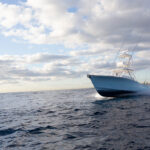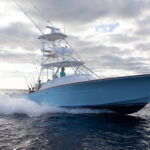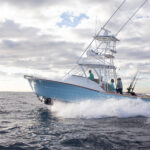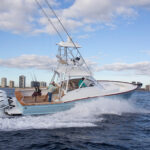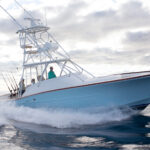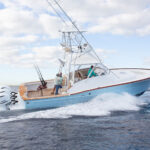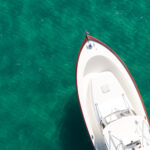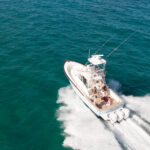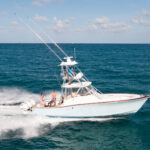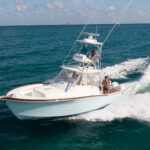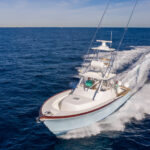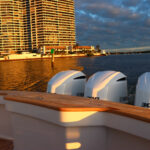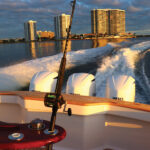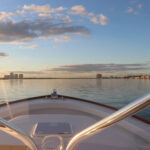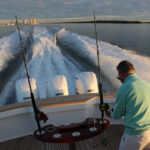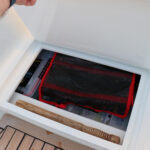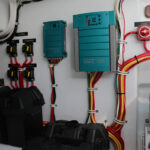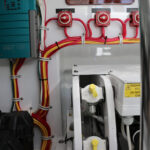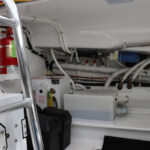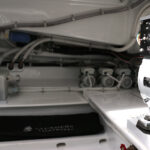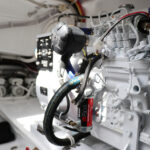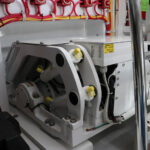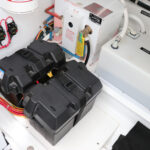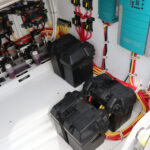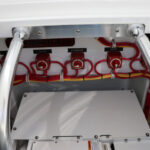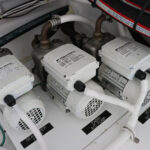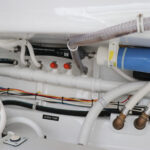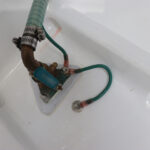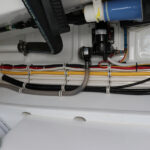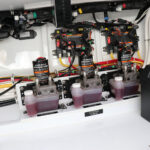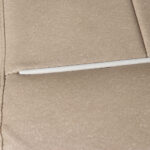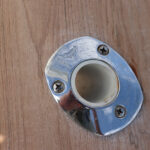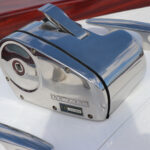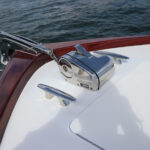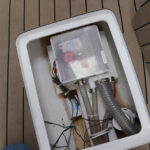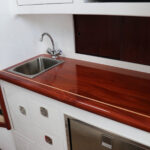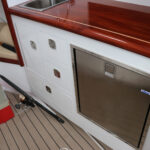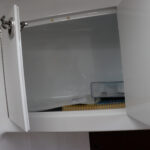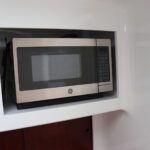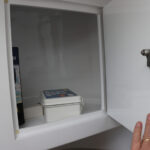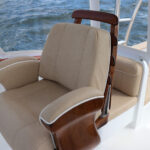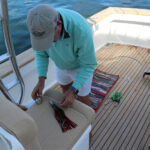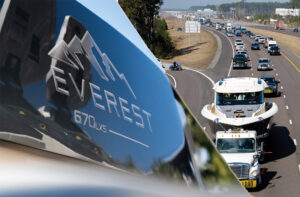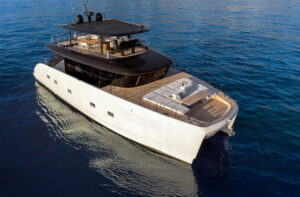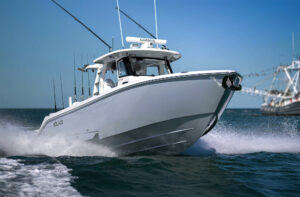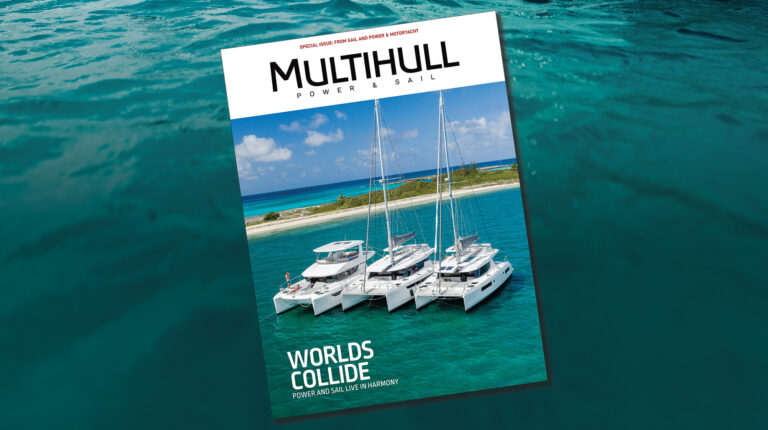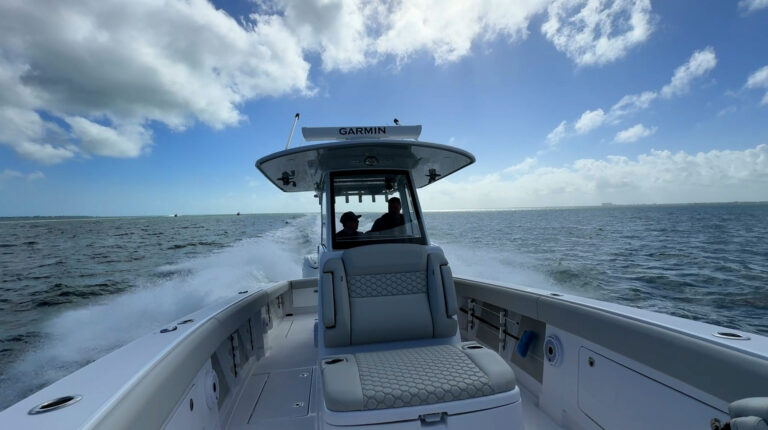Photos by Robert Holland

Battle Ready
Can a charter boat with outboard power make the big leagues? We test the Saunders Maverick 39 Walkaround to find out.
It was a fine morning at Old Port Cove Marina, a spiffy little enclave of prosperity in North Palm Beach. I’d arrived early, beating Maverick-Saunders Yachts rep Jim Bronstien to the slip. So, as the sun came up, I had a few minutes to give the Maverick 39 Walkaround, or at least her exterior, a solitary, arm’s-length appraisal. I dropped my bag on the dock and walked out onto the finger pier alongside, where I almost immediately picked up on a couple of things.
First of all, the boat’s finish—an amalgam of Awlgrip paint; wide, varnished mahogany toerails; raw Burma teak covering boards and cockpit planking; and beefy chrome-plated bronze hardware—was top-shelf. I had no doubt it could easily hold its own against competing walkarounds from other custom builders like Release, Gamefisherman and L&H.
And then there was something else, something a bit subtler. The 39 is straight-line descended from an inboard-powered charter boat built in Costa Rica—the Maverick 36 Walkaround, a vessel that’s endured hardcore usage along the Costa Rican coast for years and more particularly as a mainstay at Los Sueños Resort and Marina, a high-profile sportfishing destination on the edge of the cobalt-blue Bahía Herradura. And sure, as I’ve just noted, the 39’s got a raised-pinky finish (a la Saunders Yacht Works of Orange Beach, Alabama, which adds engines, hardware and auxiliaries to the Costa Rican-built basic boat), but her cold-molded, triple-planked, Laurel Blanco bones seemed obviously dedicated to tough, commercially-viable seaworthiness, a thing my practical nature responded to immediately.
The most noticeable example of this was the extraordinary set of wrist-thick, 12-foot-long quarterguards at the rear of the vessel—when teamed up with the equally massive rubrails and the voluptuous tumblehome in the after sections, they constituted a combo that virtually precludes scratching or otherwise damaging the hullsides when backing into a slip. Even if the skipper is dog-tired after a long day on the water and the boathandling fairy’s on vacay.
Bronstien showed up just as I was checking out the 39’s fairly unusual (at least for a walkaround custom fishboat) powerplant, a super-clean installation featuring three 300-hp Yamaha F300 outboards mounted on a positive-floatation-type Armstrong bracket, a device designed to boost buoyancy astern on outboard-powered boats, thereby promoting reasonable running attitudes at speed and balanced profiles at rest. “Well, Bill,” Bronstien said, after we’d exchanged greetings, “what say we get going?”

“Sounds cool, Jim,” I replied enthusiastically. The 39, if memory served, would be the first outboard-powered custom walkaround I’d ever sea trialed, and hey, I was antsy to know whether cantilevering an extra 1,800 pounds of machinery off the transom on a bracket would affect performance. And I also wanted to know whether the boat’s Yamaha Helm Master joystick would be truly useful for maneuvering dockside. I’d put a similar system, on a similar boat, through its paces a couple of years before and come away totally underwhelmed, primarily because the Yamahas were so slow at moving the vessel through the eye of a rousing tidal current.
Our plan for the day was simple enough—we’d sea trial the 39 on nearby Lake Worth (where sea conditions were smooth) and then take the boat out into the much sportier Atlantic, tool around a tad, beeline it down the coast some 50 nautical miles to Port Everglades and, after negotiating the inlet there, tie up at the marina behind the Pier 66 hotel in Ft. Lauderdale. As we prepared to depart, Jeff Leach, a boat-savvy friend of Bronstien’s, stopped by to hitch a ride.
Performance on the lake was solid. The average top hop I recorded was 41.7 knots, a velocity that pulled some 80 gph from the 39’s large, 525-gallon, welded-aluminum fuel tank, positioned just abaft what Saunders calls “the pump room,” an amidships space dedicated to inboard engines on the 36 but outfitted on our test boat with saltwater, freshwater and hydraulic-steering pumps; Delco house and starter batteries; a 7-kW Phasor diesel genset (with dedicated fuel reservoir); and, in addition to a raft of other items, an ever-so-practical see-through plastic holding tank. Slowing ‘er down to a cruise speed of approximately 30 knots maximized fuel economy (.84 mpg) and produced a reasonable, canyon-running range of nearly 400 miles.

Handling was quick. I skipped simulating a fish-fighting backdown in deference to the Yamahas. Chasing fish backwards is fun on an inboard vessel—not so much on an outboard one. Sightlines from the helm were excellent all the way ‘round, even coming out of the hole. And, perhaps due to the 39’s easy-to-maneuver charter boat essence, I found it unnecessary to put much effort into trim and tab adjustments while zooming across the lake.
“Before we head south,” said Bronstien after we’d finished up, “we need to take on fuel. We’ll stop at Sailfish Marina. It’s on the way out.”
“Sure,” I cheerily agreed, despite the conversation Bronstien and Leach had just concluded. With the tide percolating full tilt at Sailfish, Leach had warned that its force typically kept him from gassing up his own boat there. And Bronstien had more or less agreed, adding, “Yeah, sometimes the current can really run in there.”
Talk about an understatement! Although I entered the fairway that leads to the fuel dock on the up-tide side, I was amazed to discover that, in two seconds flat, I was doing my best to claw the 39 off the fairway’s down-tide side, which was bristling with bow pulpits and bowsprits. I looked over my shoulder to get a better handle on the dicey scene. Yikes! Bronstien nervously cleared his throat. The base price of the 39—$875,000—toodled through the ol’ noodle.

The Helm Master joystick saved my bacon, though. In part because Saunders had expertly tweaked the system but also because the 39’s transom deadrise is just 12 degrees (meaning her hullform is easier to move laterally than the hullforms of vessels with more keel-like vee under the water), I had little trouble sliding the boat sideways up-tide and out of trouble. Then I simply and quickly rotated her through the eye of the current and sidled into an alongside berth between a big sportfisherman astern and an excursion boat forward.
Driving the boat down to Lauderdale afterward was a blast. She seemed to be exceptionally dry and easy to control. En route, I dealt with easterly seas, hammering the port bow and cresting from 4 to 6 feet. Nevertheless, we tracked along nicely all the way and the only droplets to spatter the windshield arrived when I made the turn into the mouth of the Port Everglades jetties while maintaining a steady, 22-knot cruise.
But then, as I slowed down to transit the jetties in quartering seas, I found I had to deal with a somewhat exaggerated yaw. Although only a little extra steering was required to manage the issue, I decided to run it past Naval Architect Erwin Gerards, who designs for Maverick and other custom builders
Gerards’ explanation was straightforward: While the 39’s relatively flat bottom is great for transverse stability, joystick maneuvering dockside and operating efficiency, he said it calls for a modest trade-off in terms of down-sea directionality. More to the point, when coupled with a broad, beamy transom, the reduced vee in the 39’s running surface degrades tracking somewhat, at least in following or quartering seas. Hence, the extra yaw.
A couple of hours was all it took to get to Pier 66. But by the time we’d arrived, I’d pretty much made up my mind about the Saunders Maverick 39 Walkaround and her novel powerplant. Certainly, the boat’s outboard propulsion was a viable alternative to inboard power—the positive-floatation bracket at the stern seemed to almost neutralize the combined weight of her three Yamahas. The boat’s Yamaha Helm Master system certainly worked like a champ, even under sporty conditions. And finally, a gentrified charter boat like the 39 appeared to be an excellent choice for the outboard enthusiast with a penchant for angling: While her top-notch finish may belie a hardcore nature, it’s that very nature that makes her an especially sturdy, dependable and safe ride. I only wish there’d been enough time to throw a little sailfishing into our little jaunt.

Saunders Maverick 39 Specifications:
LOA: 39′
Beam: 12’9″
Draft: 2’8″
Displ.: 19,000 lbs.
Fuel: 525 gal.
Water: 50 gal.
Power (as tested): 3/300-hp Yamaha F300 outboards
Generator: 7-kW Phasor (diesel)
Price: $875,000

